Explainer
- Explainer
- World politics
Why is North Korea sending trash balloons into the South?
K-pop is blasting into North Korea once more as bizarre tactics ratchet up tensions on the peninsula. We explore what’s behind this “tit-for-tat” in an Explainer updated from earlier this year.
By Angus Holland and Jackson Graham
Emergency phone alerts are not unusual in South Korea but in recent weeks a handful have certainly caught the eye: warning citizens to steer clear of unpleasant payloads borne by “waste balloons”.
The campaign began in May when thousands of huge white balloons carrying bags of garbage – including cigarette butts and, reportedly, excrement – drifted across the border from North Korea and disgorged their contents on streets and fields in the South – some 15 tonnes in total, according to reports. In response, South Korea said it would dust off giant loudspeakers along its border with the North to recommence broadcasting propaganda messages and K-pop (Korean pop music).
Surreal, yes, but the balloon war has had a sinister edge – South Korean military have worn biohazard suits while cleaning up the loads, wary that the trash might contain biological or chemical agents. It is also a highly visible sign that friction is increasing once again between the two nations, who went to war in 1950 and, technically, remain in conflict, since no peace agreement was ever signed.
After a tentative thaw with the South in pre-COVID-19 times, North Korean leader Kim Jong-un has also ramped up his threats and the missile tests for which his nation is so well known, with 10 short-range rockets, for example, falling into the sea at the end of May. South Korea, meanwhile, has fully suspended an “anti-inflammatory” agreement it struck with its neighbour in 2018 (when, among other measures, it had shut down its loudspeaker broadcasts). How did this situation on the Korean peninsula come about?
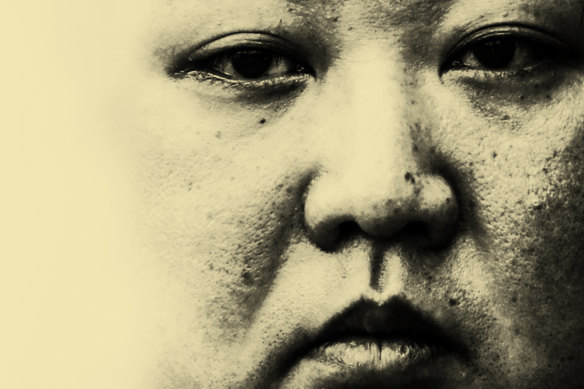
Kim Jong-un: South Korea is now a “primary foe”. Credit: Bloomberg, digitally altered
Why are we talking about North Korea again?
The Korean peninsula is the perfect social experiment, says Victor Cha, a top United States adviser on North Korea. “Let’s take two people, the same people, the same blood, put them in two different political systems and look at how things turn out.” Asia affairs director to George W. Bush, Cha is one of a handful of outsiders this century to cross overland into South Korea from the impoverished “hermit kingdom”. “I never saw a traffic jam because nobody has a car,” he says. “I saw people waiting 30- or 40-deep for a bus, or 10 people waiting to use a payphone.”
The journey through kilometre after kilometre of “just barren farmland” in the North to the industrial plants and traffic-packed highways of South Korea was a “blindingly obvious” illustration of how that experiment has turned out. “This is what happens when you have two different political systems and one is very successful and one is an abject failure.”
Yet North Korea’s regime has proven very successful in one crucial area – keeping an iron grip on power. The Kim family dynasty, now headed by Supreme Leader Kim Jong-un, spruiks a largely fictional account of its quasi-religious origins while hammering home an omnipresent threat of war to its 26 million people.
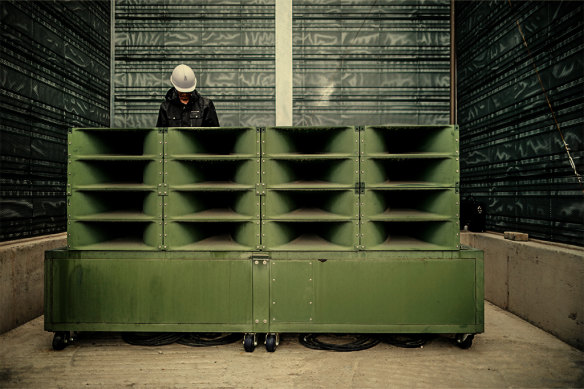
A worker dismantles loudspeakers set up for propaganda broadcasts near the DMZ in 2018. They’re now being dusted off for use again.Credit: AP< digitally tinted
Late in 2023, North Korea claimed to have made its first successful launch of a military satellite. It also test-fired what observers believed was a type of intercontinental ballistic missile, or ICBM, called the Hwasong (HS)-18, which could reach the US. South Korea called the launch a “grave provocation”. The regime has already test-fired at least four more rockets of varying types so far in 2024, says the Centre for Arms Control and Non-Proliferation in Washington, DC.
The more recent trash balloon offensive appeared to be, in part, retaliation to South Korean activists sending leaflets into the North from “smart” balloons, reported Reuters. These contain circuit-boards and timers that control how the propaganda is dispersed. The activists have also sent recorded messages, shortwave radios and bibles, the agency reported. North Korea is also believed to be installing its own loudspeakers along the border now, to retaliate to any South Korean broadcasts.
‘We do not want war but we also have no intention of avoiding it.’
Such tit-for-tat exchanges may seem ridiculous but they chart a more serious change in diplomatic relations, not least South Korea’s recent decision to fully suspend the 2018 Comprehensive Military Agreement, designed to defuse military tensions with the North.
Earlier in 2024, Kim appeared to abandon his dynasty’s goal of peaceful unification with the South, which dated back to the North-South Joint Communique of 1972. Instead, he called South Korea a “primary foe and invariable principal enemy”, and said the constitution would state that North Korea would pursue “occupying, subjugating and reclaiming” South Korea if another war was to erupt on the Korean Peninsula. “We do not want war,” he told the Supreme People’s Assembly in the capital Pyongyang, “but we also have no intention of avoiding it.” He has since shuttered government departments that focused on reunification, and, ever-conscious of Brutalist-era symbolism, ordered the destruction of a massive arch built under his father’s rule in 2001 that spanned the Reunification Highway, which leads south from the capital, describing it as an “eyesore”.
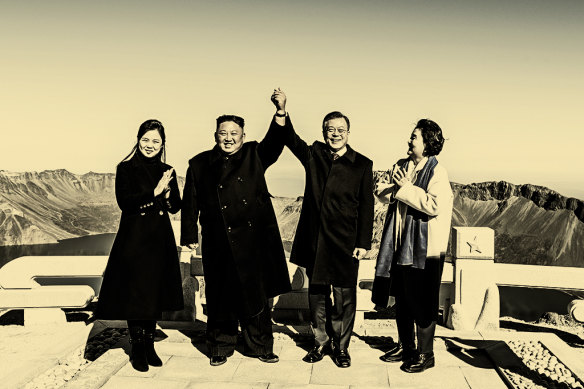
Kim Jong-un and South Korea’s then president Moon Jae-in in 2018, flanked by their wives, Ri Sol-ju (far left) and Kim Jung-sook (far right), on Mount Baektu ahead of talks on denuclearising the peninsula. Credit: Pyeongyang Press Corps via Getty Images, digitally tinted
For analysts Robert Carlin, a former senior US State Department official, and Siegfried Hecker, an expert on North Korea’s nuclear program, Kim’s moves were unusually ominous. “The situation on the Korean Peninsula is more dangerous than it has been at any time since early June 1950,” they wrote in an essay published in January on the 38 North website. “That may sound overly dramatic, but we believe that, like his grandfather in 1950, Kim Jong-un has made a strategic decision to go to war.” The danger, they added, “is already far beyond the routine warnings in Washington, Seoul and Tokyo about Pyongyang’s ‘provocations’.”
What of the routinely expressed opinion that Kim would not go to war because he “knows” Washington and Seoul would destroy his regime if he did? “If this is what policymakers are thinking, it is the result of a fundamental misreading of Kim’s view of history and a grievous failure of imagination that could be leading (on both Kim’s and Washington’s parts) to a disaster.” To break with his dynasty’s policy, they say, Kim must have seen all other options as exhausted; particularly after all he “risked and lost” when talks with then US president Donald Trump on normalising relations failed in 2019 – “a traumatic loss of face”.
As Carlin and Hecker predicted, their essay met with cold water from other analysts. Some believe North Korea’s support for Russia’s Ukraine war – its artillery rounds are showing up in battlefields in Ukraine – indicate it is a long way from preparing for its own conflict. Yet not everyone is convinced it’s business as usual.
“This seems to be something slightly different,” says Daniel Pieper, Korea Foundation lecturer at Monash University, who notes: “When it comes to nuclear weapons, I think that there’s been a shift in Western nations that it’s too late to really prevent the program. Any kind of negotiations that include giving up their nuclear program are really doomed to failure.”
Victor Cha believes the dictator’s actions early in 2024 were not as serious as previous provocations since they were reversible (razed arch excepted). But that didn’t mean the regime wouldn’t try to goad the South Korean government into retaliating, Cha said in February. “They will do more missile tests for sure but if they try to carry out some sort of conventional lethal provocation against South Korea, that has a much higher chance of escalating.”
The North has long been testing the limits of its maritime boundary in the Yellow Sea. In 2022, it fired a missile into South Korean waters, triggering air-raid alerts; and in 2010, it bombarded the South’s Yeonpyeong Island with artillery, killing four people. South Korea has one of the world’s biggest artillery stockpiles and hosts about 29,000 US soldiers as well as a Terminal High Altitude Area Defense system designed to shoot down missiles from the North.
‘Behind all this is really an attempt to carve out a more independent identity for North Korea.’
Here’s another read: Kim’s shift on reunification could be aimed largely at bolstering internal support for the regime – the classic Orwellian move of diverting focus from domestic woes. “[It’s] emphasising an external enemy, pushing people’s attention away from the severe economic issues they’re facing,” Robert Lauler, the English editor of news outlet Daily NK, told us in February. Border closures with China since the pandemic, floods and drought, and sanctions targeting the regime have worsened food shortages in the North.
“They can’t sustain even their own population through their own agriculture,” says Euan Graham, a senior analyst at the Australian Strategic Policy Institute. “They are reliant on China.”
Western popular culture, especially from affluent South Korea, continues to leak into the North. Hence, Kim’s shift in tone is “more a way to take South Korea out of the North Korean mindset”, says Graham. “Behind all this is really an attempt to carve out a more independent identity for North Korea.”
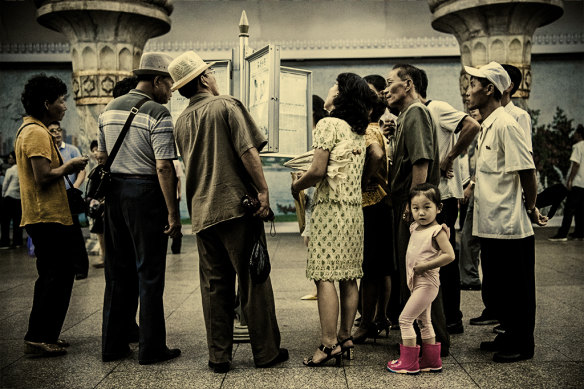
North Koreans read a newspaper in a station on the Pyongyang metro in August 2018. Credit: Getty Images, digitally tinted
What’s life like under Kim Jong-un?
Living standards remain appalling by Western measures. Food shortages are unsurprising. Personal car use is rare. Yet this is not the Dark Ages: mobile phones are commonplace, says Simon Cockerell, who, as general manager of Korea specialist Koryo Tours, was a frequent visitor to North Korea between 2002 and 2020. That said, the phones are largely used for talking – “like it’s 2001 or something” – as few North Koreans have access to the internet.
Those who want to “surf the web” (as we might have said in 2001) typically do so in a public building such as the Grand People’s Study House library in Pyongyang and are limited to sites within the local intranet, known as Kwangmyong – meaning “bright light” – a closely monitored depository of technical papers, domestic news from the regime and internal email. Only a few thousand of the well-vetted elite have access to the global net.
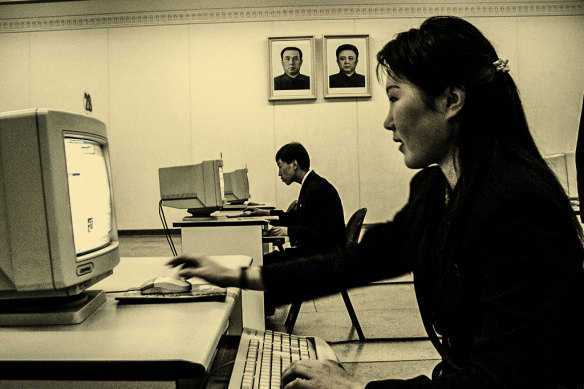
Students engage in a simulated internet chat in the Grand People’s Study House in Pyongyang, under portraits of Kim Il-Sung and his son, Kim Jong-il.Credit: Getty Images, digitally tinted
Some young North Koreans keep up with the times too, after a fashion, largely through facsimiles of South Korean garments smuggled in via China, or local knock-offs of the designer garments favoured by First Lady Ri Sol-ju. “Shoes, handbags, dresses, that kind of thing,” says Cockerell. “The biggest change that I’ve seen over the time I was there was the emergence of a kind of proto-middle class, one that felt that it was OK to display the beginnings of conspicuous consumption. That started maybe around 2009 and became a lot more prevalent. You could see that there were moneyed people, you could see that there were people who made an effort to appear better off. It’s going to coffee shops or restaurants, taking a taxi, not taking a bus.”
It’s unclear how much Western-South Korean influence is tacitly permitted but crossing the line can be catastrophic. One student was recently sentenced to death (later commuted) for smuggling and selling copies of the Netflix series Squid Game, according to Radio Free Asia. They’d been tracked down by a censorship strike force called Surveillance Bureau Group 109. According to RFA sources: “A student who bought a [computer thumb] drive received a life sentence, while six others who watched the show have been sentenced to five years’ hard labour, and teachers and school administrators have been fired and face banishment to work in remote mines.”
The regime subjects youths to “intensive study sessions” intended to “uproot the capitalist bourgeois ideologies implanted in young people’s heads and to equip them with a patriotic ideology that the Korean people are the best in the world,” reports Daily NK, which relies on a network of anonymous informers. The teaching material apparently says, “Viewing or sharing movies, television shows or news programs from other countries is completely unacceptable.”
Before she fled (via China), defector Jihyun Park feared sharing anything critical of the regime. “It could be that I thought this person was my best friend, but my best friend will report me if I say something wrong.”
Defector Yoo-seong Lee, who escaped the North via Russia in 2019, tells us residents in his homeland still live in “extreme fear”. “Every moment, they carry the terror that the regime, with its secret police, could snatch away their lives or the lives of their family,” says Lee, using a pseudonym. He says the starkest difference he saw between people in the North and South was in their economic situations. “The high buildings and the wide streets and a great number of modern cars were my first impressions [of] South Korea,” he says. “They made me weep, thinking of my family in North Korea.”
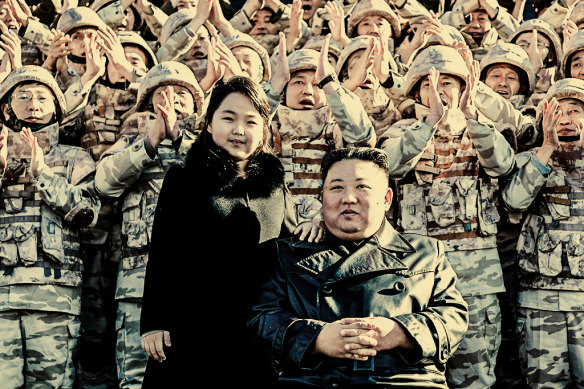
Kim Jong-un and his daughter Kim Ju-ae after the launch of a missile in 2022 in a photo supplied by the North Korean government.Credit: Korean Central News Agency via AP, digitally altered
Why the missiles?
As president, Trump nicknamed Kim Jong-un “Little Rocket Man”, which is how many in the West most often see him: gleefully watching another rocket headed off towards the Sea of Japan. He has indeed ramped up North Korea’s nuclear program and missile tests since the death of his father, Kim Jong-il, who entrenched songun, or “military-first”, as government policy. Since 2011, North Korea has test-fired more than 220 missiles with varying ranges, says the Centre for Arms Control and Non-Proliferation. In January 2023, Kim Jong-un declared he would “exponentially expand” the country’s nuclear arsenal and “mass produce” tactical nuclear weapons.
“Their ultimate goal,” says ASPI’s Euan Graham, “is a missile that has the range to reach the continental United States and directly threaten the US with nuclear retaliation or a strike.” But it’s not just about what’s technically possible. “There’s an element of prestige around military capability,” he says. “There is a strong theatrical element to what they do. What they do may appear strange from the outside but from the viewpoint of keeping themselves in power, maintaining internal controls and having a strong sense of genuine paranoia about the outside world, it all makes sense.”
United Nations sanctions were imposed largely in response to the regime’s nuclear tests, from 2006. Australia and the European Union, among others, have imposed trade bans on imports and exports such as arms, rocket fuel, precious metals, commodities, luxury goods and financial services. Yet, Kim Jong-un has somehow kept the regime’s moribund economy ticking over.
A UN panel of experts in 2018 reported North Korean financial brokers were operating freely in five countries, chief among them China and Russia, and engaged in “illicit ship-to-ship transfers of petroleum products, as well as through transfers of coal at sea”. North Korea is also believed to hold vast reserves of untapped minerals such as the rare earth metals, copper and graphite essential for electrification and high-tech products such as smartphones.
Selling arms and munitions is another money-spinner, and a way to curry favour with friends. Kim spent a week in Russia in September, his longest trip away since taking power, travelling on his armoured train for talks with President Vladimir Putin on closer military and other co-operation.
The internet comes in handy, too. Euan Graham notes the regime’s use of financial crime “through cyber-theft conducted on a massive scale internationally”.
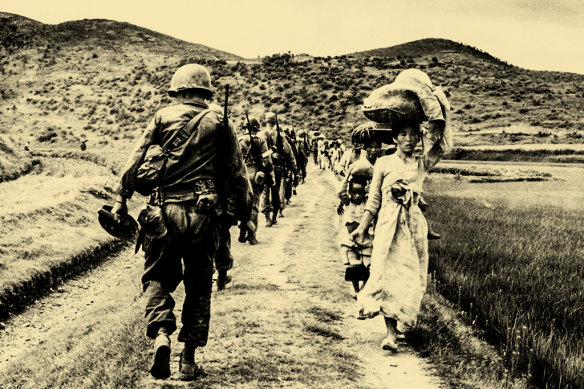
US soldiers file past Korean women and children carrying their possessions in 1950. Credit: Getty Images, digitally tinted
How did Korea split in two in the first place?
To understand the divided peninsula, it’s worth taking a step back. “North Korea lives in a very tough neighbourhood,” Graham says. “In many ways, it’s absorbed many of the kinds of dysfunctions of north-east Asia, a lot of the history that has been swept under the carpet in Japan, China and elsewhere in terms of the imperial colonial history.”
Korea’s contemporary situation dates from 1945 when, after a brutal 35-year occupation, the Japanese surrendered to Russian troops in the north and US forces in the south. A decision was made to divide administration between the two occupying forces – just while the country got back on its feet – with the Russians controlling everything above the 38th parallel and the US below it.
As Cold War-era relations grew frosty, talks over a single new government foundered. Instead of the two halves uniting, in 1948 they formally split. In the south, the Republic of Korea became a democracy led by the hardline anti-communist president, Syngman Rhee; in the north emerged the (non-democratic) Democratic People’s Republic of Korea, a Russian puppet state headed by a man hand-picked for the job: Kim Il-sung.
Kim Il-sung had grown up during the worst years of Japanese repression, both in Korea and then in the Manchurian region of China, which the Japanese invaded in 1931. He was drawn, like many of his peers, to guerilla warfare and communism, and later made a name for himself as a fighter during World War II. Exiled in the Soviet Union, he came to the attention of party bosses who earmarked him as an ideologically appropriate “cadre” to help run a communist post-war territory. “The Soviets found themselves going with this one person who had revolutionary credentials, although his credentials were far lower than most other leaders who emerged after the war in different parts of the world,” says Kyung Moon Hwang, professor of Korean history at ANU.
But even as the Soviets and Americans prepared to withdraw their World War II forces, conflict was simmering on the peninsula. Kim Il-sung, convinced war was necessary for reunification, lobbied Stalin and China’s then-leader, Mao, for approval to invade the south. “Long story short,” says Daniel Pieper, “the Soviets gave their tacit approval and materiel support whereas the Chinese devoted, if needed, boots on the ground. But it was Kim Il-sung, ultimately, that ordered the attack.“
Areas of the DMZ are home to 38 per cent of the peninsula’s endangered species, including black bears and wildcats.
On June 25, 1950, Kim Il-sung’s forces stormed across the 38th parallel. The UN rallied 21 member nations to push back, with South Korean and US troops making up the bulk of the south’s fighting strength. More than 17,000 Australians fought. About 3 million troops and civilians died in the conflict.
Oddly, the Korean War never officially ended but was paused through an armistice, which is still managed by a multinational United Nations Command, and which has left the country divided by a “DMZ” or demilitarised zone: a band of land, varying in width up to four kilometres, with barbed wire and strewn with landmines. In a twist, areas of the zone have become a wildlife haven (save for the mines), home to 38 per cent of the peninsula’s endangered species – even, it’s rumoured, tigers and leopards, says London’s Natural History Museum. “It’s literally untouched,” Cha says. “It’s kind of unforgettable.” Parts of the DMZ’s southern edge are tourist attractions, just over an hour’s drive from Seoul, including one of the four known “infiltration” tunnels dug by North Korea into the South, allegedly for an invasion, which was discovered after a tip-off from a defector in the 1970s.

Kim Il-sung inspects North Korean army assault rifles watched by his son, Kim Jong-il (right), in 1975.Credit: Getty Images, digitally tinted
How have the Kims kept their grip on power?
Ruthless oppression and a cult of personality were Kim Il-sung’s main go-tos as he built a new nation, harnessed to a political-economic philosophy known as juche: a peculiarly North Korean take on communism loosely translated as “self-reliance” with quasi-religious elements that became official policy in 1972.
Vast murals, towering statues and adoring parades became de rigueur as did absurd historical revisionism. Kim Il-sung was now no longer of common birth but from a long line of glorious leaders; he was no longer just a respected soldier but had almost single-handedly defeated the Japanese. In this, he was eventually aided by his son, Kim Jong-il, who worked in the government’s propaganda department. His skills were well-honed by the time his father died in 1994 (of a heart attack) and passed the baton to him.
Among Kim Jong-il’s other skills was said to be his golfing prowess: the first time he picked up a club, so the story goes, he shot a world record round of 34, including 11 holes in one (an impossible feat up there with claims he could change the weather by thinking about it). The truth appears to be that in 1994 an Australian journalist, Eric Ellis, on a visit to North Korea happened to ask an employee at the country’s only golf club if the “dear leaders” had ever played the noble sport. The terrified chap, Ellis told Fox Sports, “made up this fantastic story. Or maybe not, who knows?”
Off the golf course, Kim Jong-il was as repressive as his father but “almost comically incompetent in matters of economic management”, writes Korea specialist Andrei Lankov in The Real North Korea: Life and Politics in the Failed Stalinist Utopia. This was a toxic combination, amplified by the collapse of the Soviet Union, on which North Korea depended for aid. Between 1994 and 1998, hundreds of thousands of North Koreans died in a famine later referred to as the Arduous March or the March of Suffering.
The testimony brought him to tears, says Michael Kirby. “That had never happened to me in my judicial life in Australia.”
Of testimonies from about 100 people to a UN Human Rights Commission on North Korea in 2013, the most harrowing were from this period of famine, says the commission’s chair, Michael Kirby, a former Australian High Court judge. One witness spoke of having to dispose of the bodies of fellow prison-camp detainees in a vat to reduce them to ashes. “This was used as fertiliser in fields around the detention camp for the purpose of growing vegetables and food, however meagre, for the people in the detention camp,” Kirby says. The testimony brought him to tears. “That had never happened to me in my judicial life in Australia. It was a hearing of truly barbarous actions by a government that had got stuck in a time warp.”
Defector Jihyun Park says the famine was the breaking point for her. Her students, suffering from extreme hunger, were unable to study. She felt powerless to help them. “That is a very painful memory for me because I didn’t understand everything outside the country and that my country was wrong,” she says. She fled to China but was returned to a detention camp, before she escaped again in 2004. “It’s a prison just without the fence,” she says of her country of origin. “The North Korean government destroyed our human emotions.”
Kirby says the most widespread breaches of human rights were the abuses of people’s dignity. “They could only have one side of any issue presented to them,” he says. “They were obliged as children to participate in mass games honouring the Kim family, and they did not have access to newspapers, to television.”
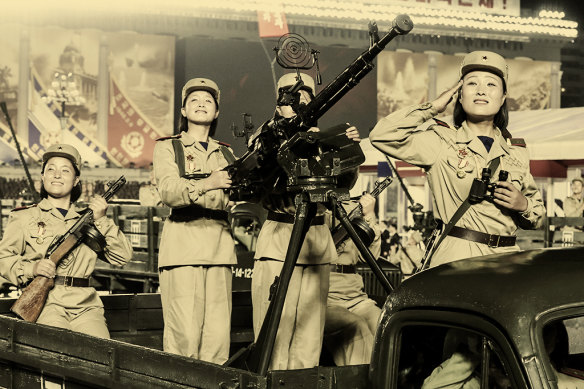
Soldiers in a parade in Pyongyang in July 2023 for the 70th anniversary of the armistice of the Fatherland Liberation War (or, the Korean War). Credit: Xinhua News Agency via Getty Images, digitally tinted
What’s the outlook for the Korean peninsula?
The election year in the US will almost certainly increase the number of provocations by the North Korean regime, said Victor Cha, the Asia and Korea chair at the Centre for Strategic and International Studies in Washington, DC. These can “be everything from conventional provocations against the South to missile tests and nuclear tests”. Kim Jong-un makes four-and-a-half times more provocations during US election years than his father did, Cha has found. “They will do more missile tests, for sure.”
A nuclear test this year, which would be North Korea’s seventh since 2006, is not impossible either, although China has condemned its past nuclear tests, which Cha says could serve as a counterweight. “The last thing that China wants this year is some sort of crisis, given the election in Taiwan and everything else, and their economic problems.”
‘Soldiers are used less for defence of the nation and more for mobilisation and construction projects; fixing roads and repairing things.’
Here’s Daily NK editor Robert Lauler’s take: “The North Korean regime isn’t really prepared to wage a war in the immediate future.
“The country is militarily strong from the outside looking in but from the inside, the North Korean military is very dilapidated. Soldiers are used less for defence of the nation and more for mobilisation and construction projects; fixing roads and repairing things.
“There’s a lot of propaganda that has been put out by the regime since the end of last year. But it doesn’t really reflect the realities on the ground. Nothing Daily NK has reported from its sources inside the country suggests there has been any war preparation, even though there is more [rhetorical] emphasis on being prepared for war inside North Korea.”
In terms of a broader solution to North Korea’s animosity, the analysts weren’t optimistic. “As long as there is this problem of a North-South division, North Korea can’t really normalise itself as a country,” says Euan Graham. “It’s trapped in this sort of cycle of experimental reform and security shutdowns, and being unable to abandon this belligerent and militarised identity.”
Even if it was to open up one day, what that would mean for its people is uncertain. “The South Koreans have developed various scenarios,” says Graham. “There would be a sort of phased approach in which South Korea and North Korea would have some federated status – but the border wouldn’t necessarily disappear.” Despite the “romantic” appeal of reunification, actually doing it would be a “very bold step”. “The last thing the South Koreans want,” Graham says, “is to inherit the mother of all unification problems that would take much longer than Germany [after the fall of the Berlin Wall] to work through and would be economically ruinous for a generation.”
Yet the past, he says, holds another lesson, too. “The contradiction for any authoritarian regime is it’s strong until it isn’t, until it’s suddenly proven to be brittle. And then things can unfold very, very quickly.”
This Explainer was published in February 2024 and has since been updated to reflect developments.
Get fascinating insights and explanations on the world’s most perplexing topics. Sign up for our weekly Explainer newsletter.
Let us explain
If you'd like some expert background on an issue or a news event, drop us a line at explainers@smh.com.au or explainers@theage.com.au. Read more explainers here.